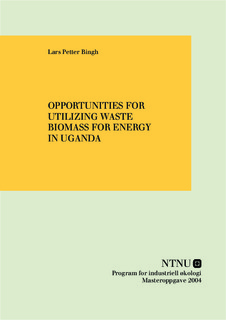| dc.description.abstract | The energy system in Uganda is largely based on biomass and especially wood. The high demand for wood results in fast reductions of the available wood stocks. This thesis is focusing on biomass waste as a supplement to the existing energy carriers. This thesis includes agricultural residues from the main cash and food crops in Uganda, as well as municipal solid waste (MSW) in Kampala. The available biomass waste resources are mapped, the energy content is examined and possible ways of utilization is discussed by using material flow analysis, MFA. The MFA flow schemes are provided for all the crops selected for studies, which are banana, cassava, potatoes, maize, rice, groundnuts, coffee and sugar cane.
The current waste collection rate in Kampala is 39 %, which means that there are large amounts of waste ending at other places than the existing landfill. The non-collected waste represents problems like bad odour, epidemics, flies, aesthetical degradation and pollution from open burning. The emissions of particles, NO and CO from open burning of MSW in Kampala are assessed by applying risk analysis. The results show that the resulting concentration of PM10 is 40 µg/m3, which is leading to a life time cancer risk at 0.56 % for the population of Kampala. The emissions of CO and NO do not represent any danger. Exposure to indoor smoke from combustion of solid fuels for cooking also represents a health risk, and there is a potential of lowering these risks by changing the energy system.
The results shows that the theoretically available crop residues represent an energy content of 4.5 TWh and constitute to 4.6 % of the firewood and charcoal currently consumed. The practical available amount (2.6 TWh) represents 2.7 % of the total consumption of charcoal and firewood in 2001 (the data includes rice husks, coffee husks, g-nut husks, bagasse and maize cobs). If the potential from MSW is included as well, the theoretical potential increases to 6.8 TWh.
An evaluation of the performance of the different fuels applied to cover the need of energy for cooking shows that electricity production from groundnut husks has the highest output of energy per unit input of mass. However, charcoal production from bagasse can serve the highest number of households, because of the larger volumes available of this resource. But, there are also practical, economical and technical barriers to overcome to utilize the biomass resources. The most promising residues for utilization when these barriers are considered are electricity production from bagasse and MSW and charcoal production from bagasse. Bagasse is available at three specific sites, so no transport is needed, and the technical experience and knowledge is already present at the sugar factories. There are more barriers to utilizing MSW as energy. The most important is to improve the collection rate of MSW from the current at 39 %. This can be done by changing the system from being based on punishment to be based on reward. Electricity production from combustion of MSW is the option which is recommended, with a practical potential at 98 GWh in 2004, and theoretical potential at 250 GWh (by 100 % collection rate). | nb_NO |
